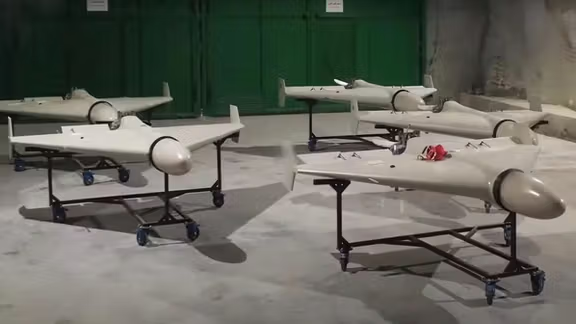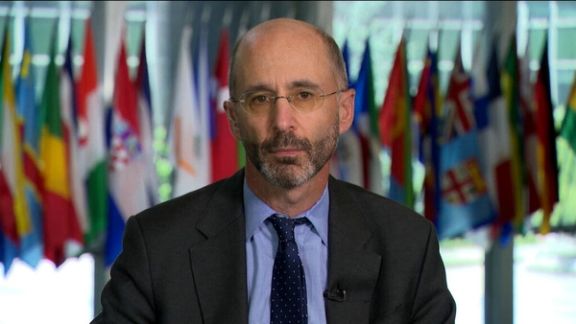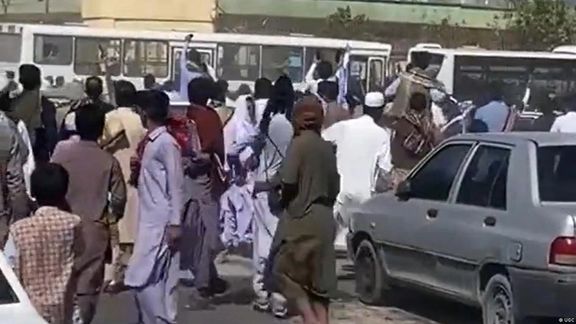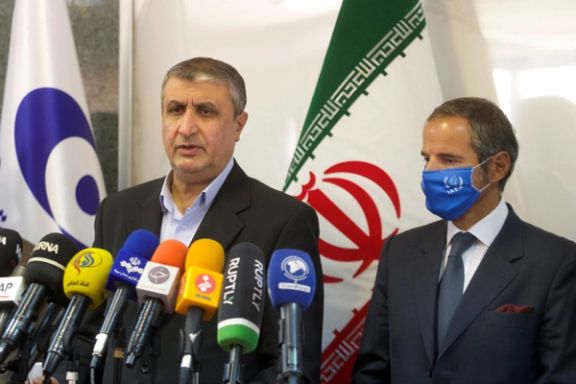Iran’s Drone Sale To Russia Violates UN's JCPOA Resolution

France said Thursday that any sale of Iranian drones to Russia is a violation of the UN Security Council resolution that endorsed the 2015 nuclear accord, the JCPOA.

France said Thursday that any sale of Iranian drones to Russia is a violation of the UN Security Council resolution that endorsed the 2015 nuclear accord, the JCPOA.
The French foreign ministry announced that it was coordinating with EU partners on how to respond, while earlier the Ukrainian officials said three Iranian-made drones were used by Russia to attack the small town of Makariv overnight targeting critical infrastructure.
"There was an overnight drone bombardment by invaders on the Makariv community," Andriy Nebytov, head of the Kyiv region police said. Russia had used more than 20 Iranian drones in its large-scale bombardment of infrastructure and cities on October 10, Ukraine said.
According to the United States, Iran has supplied Shahed 136 suicide drones to Russia and Ukraine has reported swarms of these UAVs launched against civilian targets. The drones have a low speed of 120-150km per hour and many have been shot down by Ukrainian air defenses and warplanes.
On Tuesday, October 11, President of Ukraine Volodymyr Zelensky said Russia has ordered 2,400 Iranian-made Shahed drones from the Islamic Republic.
Diplomatic efforts to reach a solution to the Iranian nuclear issue culminated in the Joint Comprehensive Plan of Action (JCPOA) on 14 July 2015 by China, France, Germany, Russia, the United Kingdom, the United States, the High Representative of the European Union (the E3/EU+3) and the Islamic Republic of Iran. On 20 July 2015, the Security Council unanimously adopted resolution 2231 endorsing the JCPOA.

Ukrainian officials said Thursday that three Iranian-made drones were used by Russia to attack the small town of Makariv overnight targeting critical infrastructure.
"There was an overnight drone bombardment by invaders on the Makariv community," Andriy Nebytov, head of the Kyiv region police said on the Telegram messaging app.
"According to preliminary information, there were no casualties." Russia used more than 20 Iranian drones in its large-scale bombardment of infrastructure and cities on October 10, according to Ukraine.
According to the United States, Iran has supplied Shahed 136 suicide drones to Russia and Ukraine has reported swarms of these UAVs launched against civilian targets. The drones have a low speed of 120-150km per hour and many have been shot down by Ukrainian air defenses and warplanes.
Kyrylo Tymoshenko, the deputy head of Volodymyr Zelenskiy's presidential office, said earlier that the attack took place by "kamikaze drones on critical infrastructure facilities", without providing further detail.
Nebytov and the region's governor, Oleksiy Kuleba, said that rescuers were working at the site.
Makariv, a town which had a population of about 10,000 before Russia's invasion in Ukraine in February, is about 55 km (34 miles) west of the capital, Kyiv.
Iran denies supplying the drones to Russia, while the Kremlin has not commented.

The US State Department said Wednesday that the Iran nuclear deal is “not our focus right now” amid popular protests, but it has done little to help Iranians.
The reality was apparent during department spokesperson Ned Price’s Wednesday briefing, where reporters kept pressing him over the lack of progress in helping Iranians to get access to the Internet that the government blocks during protests to stifle the free flow of information.
As nationwide protests began Wednesday in Iran, the government shut down most Internet access in major cities. Washington reporters were aware of that and pressed Mr. Price for answers.
The fact is that there is very little the Administration or US technology companies can do to help connect Iranians to the Internet, at least in the near future. There are two major reasons for this.
First, gateways to Internet traffic are controlled by the government and if it decides to shut off mobile data connection or even home landlines during protests, there is hardly anything foreign entities can do to help.
Second, even if the Administration removes all impediments for US companies to sell software and hardware to Iranians, it would be an extremely difficult task to bypass Iranian government controls.
The Islamic Republic is an authoritarian regime, with 80 percent of the economy controlled by the government and the concept of business freedom is almost non-existent, except at some retail level. The government tightly controls all imports. That would block any attempt to export hardware to Iran.
In terms of software, most Iranians do not have the resources or the banking means to purchase a license from a foreign source or download software they need to pay for.
Free software can be made accessible by US or other international companies, but if the regime really wants to make it hard, it will designate procurement of such software a criminal offense and try to block access.
Apart from these difficulties, providing access to the Internet is a relatively small issue compared with the main problem, which is the use of brutal force by the government against its people.
The US has imposed sanctions on a few individuals since the protests began, but beyond that has not acted to penalize the clerical regime, even as its leader Ali Khamenei on Wednesday called for more repression against protests.
The statement by Price that the Biden Administration is not focused on reviving the Obama-era nuclear deal, which would provide tens of billions of dollars to the repressive government, was a signal well received by Iranians on social media. But many argue that the US should impose more sanctions and enforce existing ones more rigorously to pressure Tehran.
A report by The Sun on October 12 quoted several Washington sources as saying that “there is a growing rift between officials at the treasury department, who are urging Mr. Biden to intensify sanctions in support of protesters, and Mr. Malley, the special envoy who prizes a renewal of the 2015 nuclear deal above all.”
An Iranian American community organization, NUFDI, wrote to Secretary of State Antony Blinken on October 11, asking for a major review of US Iran policy and personnel changes at the State Department, namely replacing Mr. Malley as US envoy. The group emphasized that the Administration needs an envoy to the Iranian people, not a diplomat focused on reviving the nuclear deal.

Russia has ordered 2,400 Iranian-made Shahed drones from the Islamic Republic, President of Ukraine Volodymyr Zelensky said Tuesday.
Speaking via video link at the G7 summit, Zelensky appealed to the leaders of the G7 countries with a request to provide air defense and missile defense systems of medium and long range, and added that such systems will create a layered defense system.
"An air shield for Ukraine. This is part of the security guarantees that are an element of our formula for peace. When Ukraine receives a sufficient number of modern and effective air defense systems, the key element of Russian terror – missile strikes – will stop working," he said.
He thanked those countries that have already provided air defense system, “which makes it possible to neutralize some of the Russian missiles and drones. But Russia has ordered 2,400 Shaheds in Iran alone, according to our intelligence."
Addressing the leaders of Western powers each by name Zelensky said, “We are very much looking forward to the delivery of SAMP-T systems. And if possible, they are needed in the coming months.”
Zelensky said Monday, October 10, Russia had used Iran-made drones to attack dozens of civilian targets in Ukraine.
The Ukrainian military claimed on October 8 that Russia has sent Iranian military drones to Belarus for possible attacks in western or central parts of Ukraine.

Many Iranians have taken to social media in the past few days to refute allegations of sectarianism levelled at some protesters by officials and hardline media.
Pro-government officials and media have increasingly been accusing protesters of “terrorism” and “fomenting sectarianism” following their harsh crackdown on demonstrators in the Baluch city of Zahedan in the southeastern province of Sistan and Baluchestan September 30, which left nearly a hundred dead, including children and bystanders, and the ongoing crackdown in Sanandaj in the western Kordestan (Kurdistan) province.
Protests will result in Iran's partition if the government does not crack down, they warn. They also blame “foreign enemies” and “terrorist groups” for the unrest that began 24 days ago when Mahsa Amini, a young woman was killed in police custody, and has spread since then.
Antigovernment activists say that the harsh crackdown on ethnic groups is the government’s tactic to foment more tensions and appear as the savior of Iran’s territorial integrity and public security.
The Revolutionary Guards (IRGC)-linked Tasnim news agency wrote Saturday that because “foreigners failed” to use the ethnic card in the protests they resorted to other disruptive tactics.
Tasnim was referring to a hactivist group’s disruption of a state TV’s news program which suddenly transitioned from a clip showing Supreme Leader Ali Khamenei to chants of “women, life, and freedom”, the signature slogan of the current protests, or revolution, as many describe it now.
The IRGC which had initially not used overwhelming military force against protesters on the streets, has been attacking the positions of Kurdish Iranian insurgent groups in Iraqi Kurdistan with artillery and drones in the past three weeks.
Sectarian groups have been active in both provinces for decades but there is no indication, judging from the slogans protesters chant in both places that they are fighting for any cause other than toppling the clerical regime.
“Down with the Dictator” and “Death to Khamenei” are at the top of the protesters’ list of slogans in Zahedan, capital of Sistan and Baluchestan, and Sanandaj, capital of Kordestan, as in all other areas of the country.
“The people of Kordestan donated blood for the people of Zahedan and chant ‘Kordestan supports Zahedan’. Accuse them of separatism if you dare!”, a supporter of protesters tweeted.
“You had ‘separated’ us for 43 years: men from women, the younger from the older generation, the Kurds from the Turks, The Luris from the Baluchis, the Persian speakers from the Gilaki speakers, … We have just united to separate the Islamic Republic and its clerics from our Iran,” another tweet which has become very popular said.
Others have pointed out in their social media posts that officials consistently refer to peacefully protesting university students as “rioters’, celebrities who have supported protesters as “lackeys of the West”, ethnic groups as “separatist” and claim that the youth who have turned into the driving force of the protests as kids who are only acting up.
“You are resorting to everything you can to instigate sectarianism in some part of the country [but you keep failing]. You tried Baluchestan but you failed, now you are targeting Sanandaj. No part of the Iranian territory has been or will be separated from it. Whenever it happened [in the past] it was because of the incompetence of the rulers at the time. You’ve lost your power of tricking people,” US-based Iranian journalist Ehsan Karami tweeted.

With talks over reviving the 2015 nuclear agreement in abeyance, Iran is continuing to expand uranium enrichment using relatively advanced machines.
A confidential report by the International Atomic Energy Agency (IAEA) to member states, seen by Reuters Monday, confirmed Tehran had brought onstream three clusters of IR-6 centrifuges at the underground Natanz enrichment plant. The 2015 agreement, the JCPOA (Joint Comprehensive Plan of Action), allowed Iran to use only IR-1 centrifuges, but Tehran began to exceed the agreement’s terms in 2019, the year after the United States left the JCPOA and imposed ‘maximum pressure’ sanctions.
The IAEA reported in August that Iran was carrying through plans announced in June to use three cascades of IR-6s at Natanz with just one at that time operational. These cascades are enriching to 5 percent, well short of Iran’s highest enrichment level of 60 percent, but using more advanced centrifuges enhances Tehran’s capacity, making it easier and quicker to achieve 90 percent ‘weapons grade’ enrichment – an aim Iran denies.
The Iranian parliament in December 2020 – following the killing of scientist Mohsen Fakhrizadeh widely attributed to Israel, which opposes the JCPOA – passed legislation it had drafted earlier despite objections by then President Hassan Rouhani requiring the installation of 1,000 IR-6 centrifuges by the end of 2021, a target the Atomic Energy Organization of Iran (AEOI) failed to meet.
By May, there were 538 IR-6 centrifuges in two cascades at Fordow and one cascade at the above-ground Natanz pilot plant. The AEOI announced plans in June to install two more IR-6 cascades underground at Natanz, in addition to one already planned there, which appeared to bring the AEOI in line with the 2020 law.
While IR-6 centrifuges have been used at Fordow and at Natanz above ground to enrich to 60 percent, some specialists have suggested Iran faces technical difficulties with more advanced machines with progress also hampered by the June 2021 attack on the manufacturing plant at Karaj, also attributed to Israel.
Biden anxiety
Talks aimed at restoring the JCPOA have appeared frozen since April, when Iran and the US exchanged several communiques through European Union mediators. Some analysts attribute the delay to the US November 8 Congressional elections with President Joe Biden anxious not to add Republican criticism of Iran policy to the unpopularity of high gasoline prices.
While the three European JCPOA signatories – France, Germany and the United Kingdom – have aligned with US criticism of Iran over its responses to IAEA questions over pre-2003 nuclear work, Russia and China have argued that both Washington and Tehran need to negotiate more seriously.
Iran has said both that the pre-2003 IAEA enquiries, centered on unexplained uranium traces, should be shelved, citing a 2015 precedent, and that it needs ‘guarantees’ against economic damage should the US leave a renewed JCPOA and reimpose sanctions. Wang Chang, deputy head of China’s IAEA mission, told the IAEA board last month that there was “neither urgency nor proliferation risk” in “possible nuclear activities that took place decades ago, if at all.” China is an ally of Iran and the only major buyer of Iranian oil, ignoring US sanctions.
Reports in August that US-Iran contacts had found a form of words dealing with the IAEA enquiries apparently came to naught. IAEA director-general Rafael Mariano Grossi in an interview August 23 suggested questions over the uranium trades might be better tackled with the JCPOA back in place. Grossi met with AEOI head Mohammad Eslami in New York in September.